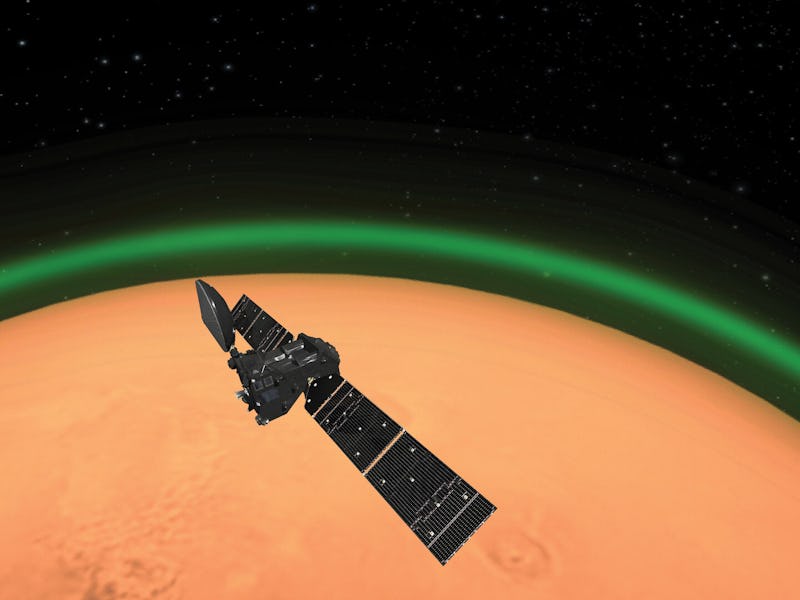Photo: Scientists detect strange, Earth-like glow in Martian atmosphere
This marks the first time these emissions are seen on a planet other than Earth.

While cruising through the Martian atmosphere, a small orbiter noticed something unusual. The Red Planet had a glowing green hue around it, a phenomenon that has never been observed on any other planet besides Earth.
The European Space Agency's (ESA) ExoMars Trace Gas Orbiter detected glowing green oxygen emissions in Mars' atmosphere, similar to the emissions that produce Earth's famous auroras.
"This suggests we have more to learn."
The new discovery was detailed in a study published this week in the journal Nature Astronomy.
Although scientists had never observed this green glow around Mars before, it was predicted that it exists nearly 40 years ago.
The glowing hue is a result of sunlight interacting with atoms and molecules of a planet's atmosphere.
“One of the brightest emissions seen on Earth stems from night glow," Jean-Claude Gérard of the Université de Liège, Belgium, and lead author of the study, said in a statement. "More specifically, from oxygen atoms emitting a particular wavelength of light that has never been seen around another planet.”
The Northern Lights are a type of aurora, which are phenomena caused by bouts of space weather. As the Sun emits charged particles in the form of solar wind, they excite oxygen and nitrogen atoms in Earth’s ionized upper atmosphere, causing auroral emissions that result in the varying colors of light that we see in the skies here on Earth.
Auroras take different forms: They can appear as patches of light, arcs that curve across the sky, or as rays breaking through the sky — and each one has its own fingerprint.
Earth's green night glow can be quite faint, and hard to observe from Earth. Therefore, it is often observed from onboard the International Space Station as astronauts capture the planet's atmosphere from an edge-on perspective that reveals its green halo.
Earth's green glow as captured from onboard the ISS.
In order to view the green glow surrounding Mars' atmosphere, the team of scientists behind the new study took the same approach using the Ultraviolet and Visible (UVIS) channel of the NOMAD instrument on the ExoMars Trace Gas Orbiter.
“Previous observations hadn’t captured any kind of green glow at Mars, so we decided to reorient the UVIS nadir channel to point at the ‘edge’ of Mars, similar to the perspective you see in images of Earth taken from the ISS,” Ann Carine Vandaele, a researcher at the Institut Royal d'Aéronomie Spatiale de Belgique, Belgium, and co-author of the study, said in a statement.
They scanned the Martian atmosphere at altitudes ranging from 20 to 400 kilometers from the Martian surface twice per orbit between April 24 and December 1, 2019. After the scans, the team found the green glow in Mars' atmosphere in all of the resulting datasets, with the emissions being at their strongest at an altitude of around 80 kilometers.
“The observations at Mars agree with previous theoretical models but not with the actual glowing we’ve spotted around Earth, where the visible emission is far weaker,” Gérard said. “This suggests we have more to learn about how oxygen atoms behave, which is hugely important for our understanding of atomic and quantum physics.”
The study found that the emissions were mostly produced as carbon dioxide, and is then broken up into its constituent parts: carbon monoxide and oxygen. The resulting oxygen atoms were also glowing both in visible and ultraviolet light, with the visible emissions being 16.5 times more intense than the ultraviolet.
By observing Mars' atmosphere, scientists can gain tremendous insight into the composition of the atmosphere, and how it changes with the Sun's activity and Mars' orbit around its host star.
Scientists have been hunting for clues of an ancient life on Mars, believing that the now desolate, dry planet may have once been a warm, wet world capable of hosting life but has gradually lost its atmosphere over the billions of years of its existence. Therefore, gaining insight into the Martian atmosphere could inform the planet's origin story and history of possible life.
Abstract: The oxygen emission at 557.7 nm is a ubiquitous component of the spectrum of the terrestrial polar aurora and the reason for its usual green colour1. It is also observed as a thin layer of glow surrounding the Earth near 90 km altitude in the dayside atmosphere2,3 but it has so far eluded detection in other planets. Here we report dayglow observations of the green line outside the Earth. They have been performed with the Nadir and Occultation for Mars Discovery ultraviolet and visible spectrometer instrument on board the European Space Agency’s ExoMars Trace Gas Orbiter. Using a special observation mode, scans of the dayside limb provide the altitude distribution of the intensity of the 557.7 nm line and its variability. Two intensity peaks are observed near 80 and 120 km altitude, corresponding to photodissociation of CO2 by solar Lyman α and extreme ultraviolet radiation, respectively. A weaker emission, originating from the same upper level of the oxygen atom, is observed in the near ultraviolet at 297.2 nm. These simultaneous measurements of both oxygen lines make it possible to directly derive a ratio of 16.5 between the visible and ultraviolet emissions, and thereby clarify a controversy between discordant ab initio calculations and atmospheric measurements that has persisted despite multiple efforts. This ratio is considered a standard for measurements connecting the ultraviolet and visible spectral regions. This result has consequences for the study of auroral and airglow processes and for spectral calibration.